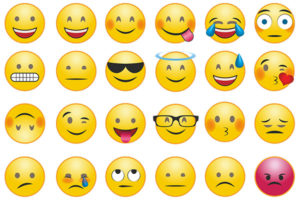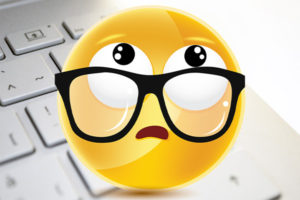The history of emojis and emoticons
The emojis and the emoticons are 2 different languages that do not have the same story.
- Emoticons are a symbol that is written using keyboard characters like; ) allowing to convey a message by differentiating emotions. Besides emoticon is the contraction of “emotion” and “Icon”. Invented in 1982 by a computer scientist, the definition given by Wikipedia is this :
emoticon is “a short symbolic representation of an emotion, a state of mind, a feeling, an atmosphere or an intensity, used in a written speech. “
- Emojis they arrived a little later. It was the Japanese company NTT NoCoMo that allowed them to emerge in 1999. This telephone company wanted to find a solution to save data on messages sent by users. DoCoMo therefore has invented the emoji which allows turn an emoticon into a picture and therefore to consume less data and fewer characters per message.
Emojis in a few figures
It is estimated that there will be 45x more emojis in 2022 than there were in 1995!
Its number should therefore reach 3,460 emojis in 2022 . Emojis have become common use today, everyone uses them inmessage exchanges or social networks .
Images are louder than words: nearly 8 billion emojis are sent around the world every day.
In an era where we have never communicated so much in writing, pictograms are a way of giving information to better understand each other.
According to our source .
Emojis are far from harmless. They are both a reflection of history (such as the disappearance of the Taiwanese flag emoji on Chinese iPhones, the government of the Middle Empire being at odds with Taiwan) and at the same time the mirror of the concerns of our people. companies. It can range from anecdotal debates like the place of cheese in the cheeseburger or the disappearance of the hard-boiled egg in the salad to more serious subjects like the anti-gun mobilization in the United States with the transformation of the emoji revolver in an apple green water pistol.
Changes that may seem anecdotal, they are nonetheless the witnesses of the debates that shake our society and can have a lasting impact, although minimal, on the conscience.

Are the meanings of emojis the same all over the world?
- One of the most used emojis, 🙂, namely a simple smile, could pass for universal. But it is not: in China, your correspondent will make a funny face if you send him this “smiley”, even with the best intentions in the world. Indeed, over there, 🙂 is not at all a sign of happiness: it is, by far, the least positive emoji of the whole range of positive emojis available, such as 😁, 🤭 or even 👍. In other words, using 🙂 implies a certain mistrust, even disbelief, closer to our understanding of “🤔”.
- The “applaud” emoji 👏 is usually associated with congratulations or support (sometimes more or less ironic). However, in China, 👏 symbolizes making love.
- The emoji 👋 is commonly used to say “hello” or “goodbye”. But, still in China, it is also used to signify a friendly or romantic breakup; a definitive “goodbye”, in short. So avoid using it with your Chinese friends!
- If 😇 can relate to innocence (again, sometimes with irony), it can also represent a prayer, or a blessing, for the most religious people, especially in the United States or Latin America, where the emoji relates more to “doing good around oneself”. But beware: in China, this emoji is used to signify death (yes, despite that smile 😇) and can be seen as a veiled threat.
- Finally, the meaning of the “pile of poo” emoji – 💩 – is also very interesting. Indeed, if this emoji has always been universally related to what happens in the privacy of the office, it can also, in certain circumstances, relate to the Japanese Kin No Unko, which is literally translated as “golden poop ”. Kin No Unko is a Japanese cultural phenomenon linked to a famous play on words, “Kin No Unko” meaning both “good luck” and “golden poo”, according to its intonation. 💩 can therefore be used to wish success. The Japanese counterpart of our “mer * e” meaning “good luck”!
( Source )
Are the meanings of emojis the same all over the world? The answer to our question is therefore NO.
That is why, emojis can never replace words. If they can be used as a non-verbal language between 2 people, be careful with misunderstandings.
Before using or wanting understand an emoji , better know who you are chatting with. Obviously, to avoid any confusion, it is better to put a few words between your emojis to make you understand.

World Emoji Day: July 17th
On the occasion of world emoji day , the site Emojipedia unveils the list of new characters expected to be added to Unicode 14.0 in September.
In 2021, it is the “ hand shake Which should be highlighted. A new tool will allow you to change the skin color of the two interlocutors, as well as to send only a hand as an invitation.
In the list of novelties we will find: a face with the mouth in diagonal, a face with the military salute, a face which hides the eyes, an emoji which shakes the hand, a heart emoji with the hands… On the side of the objects we find a buoy, a slide, a disco ball, an identity card, a crutch …

